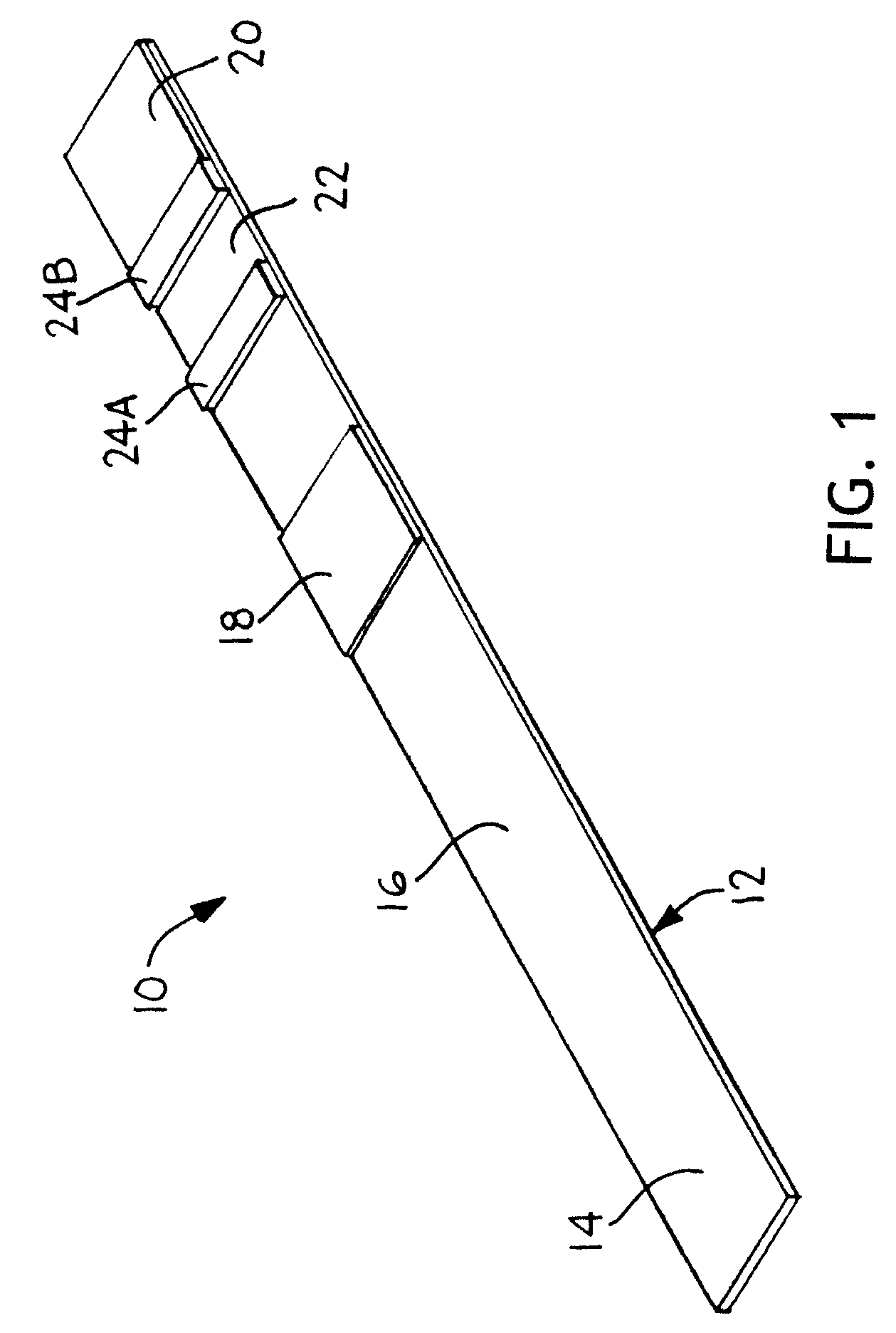Lateral-flow porous membrane assay with flow rate control
a porous membrane and flow rate technology, applied in the direction of instruments, analysis using chemical indicators, bandages, etc., can solve the problems of dehydration or hypohydration, the continuous flow of commercial dipsticks, and serious consequences for dehydrated people, so as to reduce the continuity of the membrane structure, increase the amount of time, and increase the flow time
- Summary
- Abstract
- Description
- Claims
- Application Information
AI Technical Summary
Benefits of technology
Problems solved by technology
Method used
Image
Examples
example 1
Preparation of Components:
[0049]An 81 mm×300 mm Mylar backing card is laminated with 50 mm wide nitrocellulose membrane from Millipore. The distal end of the card is laminated with a 20 mm wide porous membrane from Millipore with a high liquid capacity that serves as an absorptive sink. The absorptive sink is positioned in fluid contact with the nitrocellulose membrane, with a total overlap zone of 3 mm. A 25 mm wide glass fiber pad from Millipore is laminated to the proximal end of the card and is in fluid contact with the nitrocellulose membrane with a total overlap zone of about 3 mm. The glass fiber serves as both the sample deposition zone and the conjugate pad. The conjugate is dispensed into three discrete bands on the conjugate pad with a liquid handling system from BioDot prior to assembly of this device. The conjugate consists of a C-reactive protein (CRP) monoclonal antibody conjugated to a gold label, with optical density 3.3. The detection zone contains a CRP antibody a...
example 2
Preparation of Components:
[0052]A 2 cm×30 cm piece of cellulose pad from Millipore Co. is soaked with 5 ml of polyacrylic sodium salt that is titrated to pH of 8.1 with 1N HCl. The pad is air-dried overnight to make a buffer pad. A 10 cm×10 cm piece of Biodyne Plus Nylon membrane from Pall Co. is soaked in a 30 ml of bromothymol blue aqueous solution (0.1 mg / ml) for 10 minutes and air-dried overnight to make a test pad. A 10 cm×10 cm piece of Biodyne Plus membrane is soaked with an aqueous solution containing bromocresol green (0.2 mg / ml) and citric acid (2 mg / ml) for 10 minutes and air-dried overnight to make a control test pad.
Assemble the Device with a 3 mm Wide Flow-Rate Control Zone:
[0053]On an 8 cm×30 cm supporting plastic card was laminated with a 5 mm wide strip of Biodyne B membrane. 2 cm from the edge of the card to make a flow-rate control zone. A 6 mm wide strip of a cellulose wicking pad was laminated on the card with a 1 mm overlap with the Biodyne B membrane on one si...
PUM
| Property | Measurement | Unit |
|---|---|---|
| length | aaaaa | aaaaa |
| length | aaaaa | aaaaa |
| area | aaaaa | aaaaa |
Abstract
Description
Claims
Application Information
 Login to View More
Login to View More - R&D
- Intellectual Property
- Life Sciences
- Materials
- Tech Scout
- Unparalleled Data Quality
- Higher Quality Content
- 60% Fewer Hallucinations
Browse by: Latest US Patents, China's latest patents, Technical Efficacy Thesaurus, Application Domain, Technology Topic, Popular Technical Reports.
© 2025 PatSnap. All rights reserved.Legal|Privacy policy|Modern Slavery Act Transparency Statement|Sitemap|About US| Contact US: help@patsnap.com



